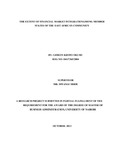| dc.description.abstract | The countries of the East African Community (EAC partner countries) are aiming for full economic integration. To this end, they have recently ratified the Common Market Protocol and attention is now turning to monetary and financial integration and the negotiation of a Monetary Union Protocol. To achieve financial integration, barriers to international movement of capital across national boundaries would need to be removed. Free capital movement across national borders among countries with different currencies requires the integration of foreign exchange and money markets. Capital movement would be difficult between two countries if the currency of one country cannot be converted into that of the other. A well-established regional foreign exchange market is thus a crucial step towards financial integration. This paper seeks to quantify existing financial barriers among East African Community (EAC) member countries based on analysis of each member country’s foreign exchange market. It is possible to construct a theoretically sound and computationally easy measure of financial openness based on deviations from covered interest rate parity (CIP). This paper develops such an indicator for Kenya, Tanzania, and Uganda using forward foreign exchange and inter-bank interest rate data for these countries. Burundi and Rwanda are not included here since forward foreign exchange data for these countries is not available. More precisely, the paper examines empirical deviations from CIP for each of these countries using forward contracts between domestic currency and the U.S. dollar. Its empirical results, which are corroborated by other evidence such as the levels of development of the financial markets and restrictions on capital flows, suggest that Kenya is the EAC’s most financially open country, followed by Uganda, and then Tanzania. The fact that the three countries exhibit different degrees of financial openness suggests that financial integration in the EAC region has a long way to go. | en |

